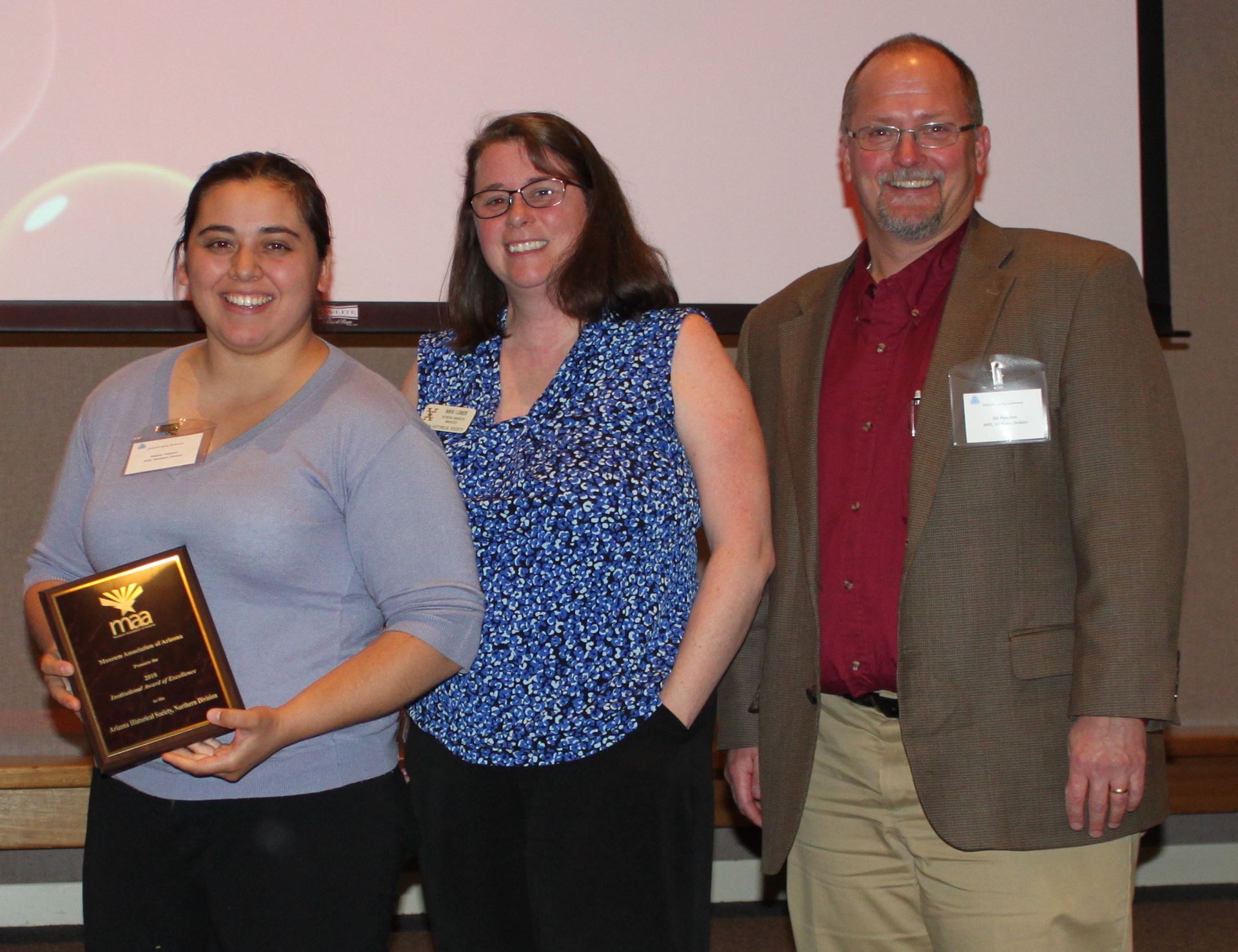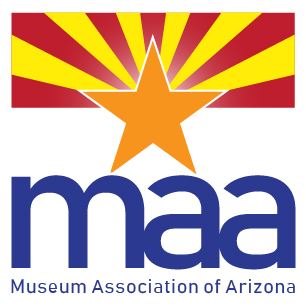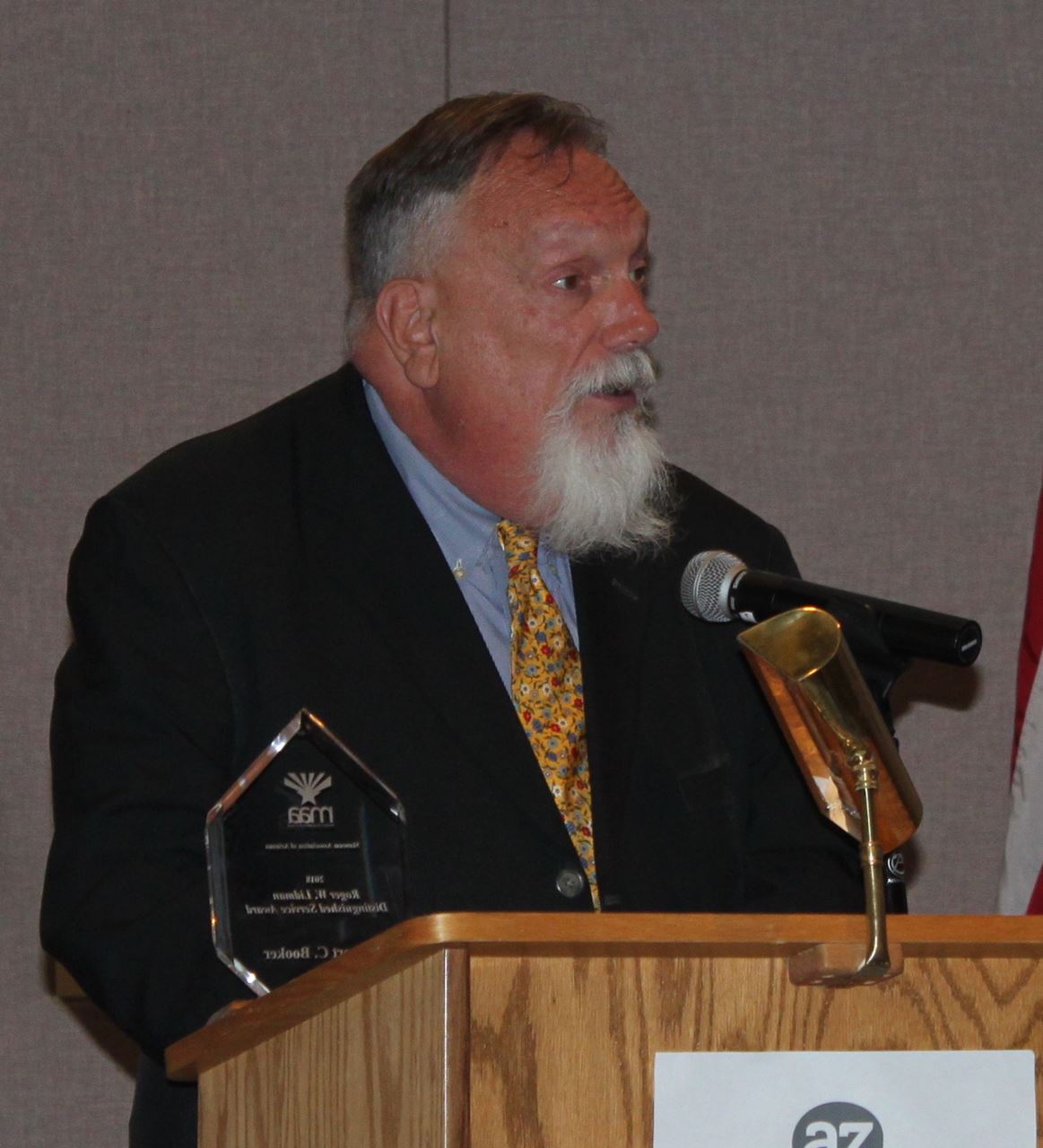Museum Association |
2018 Professional Recognition Awards
Individual Award of Excellence: David Andreasen
David Andreasen has been the volunteer Collections Specialist for the Old Trails Museum in Winslow, Arizona, since he moved there in 2011. At that time the museum’s new director and a small corps of volunteers faced a building full of uncatalogued objects with limited expertise in collections management. Mr. Andreasen was a newly-retired transplant from Maine, with a wealth of knowledge and experience from his work in Special Collections at the University of Southern Maine, and the University of North Florida. He arrived, eager to volunteer, at just the right moment to help us with this daunting project.
In addition to his work with the paper, textile, and object collections - building archival cabinets, and special containers; reorganizing and expanding the archives; repairing documents, photographs, and books; upgrading the museum’s PastPerfect software; and developing the policies and procedures for the museum’s first Collections Management Plan - he also acts as the “I.T. guy”, diagnosing and troubleshooting computer and network issues; as a construction worker and handyman building shelves, installing lights, and hanging photographs and paintings; and as an artist, creating artwork for fundraising and logos for special events and projects. He is also the museum’s most active substitute volunteer, covering shifts and hosting visitors as needed.
The scope and impact of David Andreasen’s contributions cannot be overstated. Simply put, the Old Trails Museum is a better institution because of him. He will leave a valuable legacy, preserving the Old Trails Museum and the history of Winslow for future generations.
Individual Award of Excellence: Jannelle Weakly
Jannelle Weakly has had a 17-year long career at the Arizona State Museum, working in many areas of the museum, including collections management, exhibit development, preservation, and research.
For the last 6 years she has served as Curator of Photographic Collections. Notable among the recent projects she has worked on is Life Along the River, focused on the ancestral site of Homol’ovi, and the newly opened permanent exhibit Woven Through Time, in each case researching and writing label copy for the 70 to 100 photographs used in each exhibit. In 2014 she co- curated Regarding Curtis: Contemporary Indian Artists Respond to the Curtis Imagery, an ground-breaking exhibit that explored the work of famed photographer Edward S. Curtis in relationship to the work of contemporary Indian artists.
She has also been active as a grant writer,, obtaining funds to rehouse and digitize an important Southwestern photographic collection, as well as working on multiple proposals that will create a “photographic storage vault” that will provide cutting edge storage for the preservation of the museum’s images.
Finally, she provides leadership and advice outside of the museum, as a contributor to the Arizona Memory Project, serving on the University of Arizona’s Research, Discovery & Innovations Office’s Cultural Institutions Technology Working Group, and assisting and advising the curators and archivists at the HuHuGam Heritage Center.
Jannelle Weakly is highly regarded as an extraordinary curator by her colleagues, acting as an agent of change for her museum and university, and as an advocate of best practice and highest standards in the museum field.
Individual Award of Excellence: Gina Watkinson
Gina Watkinson has worked for the Arizona State Museum since 2007 at the Conservation Laboratory. After providing leadership while Lab director Nancy Odegaard was on sabbatical she has been an essential member of the business conservation lab ever since.
She is the “go-to” person for the lab, coordinating student interns and graduate fellows, as well as the many volunteers – as many as 12 people at a time. She is also responsible for safety compliance and participates in nearly all the research projects and professional presentations that are produced by the lab.
Over the years she has also become the “go-to” person for the entire Arizona State Museum, assisting with museum-wide events ranging from art fairs to basketry festivals to open houses. She also represents the museums to the wider Arizona community, responding to requests from the public and colleagues for assistance and information.
Nationally she has been a Smithsonian Summer Institute in Museum Anthropology Scholar and a participant in the Smithsonian Affiliates Visiting Professional program. In addition to serving on professional organization committees, she regularly leads training sessions and workshops for the Association for Tribal Archives, Libraries, and Museum, the Western Museum Association, the American Institute for Conservation, the American Alliance of Museums and, of course, the Museum Association of Arizona.In the words of her nomination, her hard work and accomplishments are inspirational and praiseworthy, and deserving of recognition from her colleagues as a true museum professional.
Institutional Award of Excellence: Chandler Museum
The Chandler Museum’s exploration of the story of Japanese Internment and the Gila River Internment Camp, located only a few miles south of Chandler during World War II, through multiple exhibit and presentations engaged not only members of their community, but far beyond.
The first step was a kiosk that provided key historical information about the Camp for the renamed city park Nozoni Park, created through a partnership with the National Park Service, the Gila River Indian Community, the City of Chandler and the Japanese American Citizens League,
Next up was hosting the traveling exhibit at the museum, Art of Survival: Enduring the Turmoil of Tule Lake, which was followed by creating an in-house exhibit, Un-American: Japanese Internment in Our Backyard. A mobile banner version of the kiosk was also created to enable the interpretation to pop-up throughout the community.
A community-engaging art installation involved collecting and displaying 16,655 origami paper cranes – one for each internee incarcerated at Gila River. Although intended for the local community, the response from individuals, families and organizations was astounding, and all 16,655 cranes were collected in only three months, coming from as far as away as New York and Hawaii.
Not only did this project establish the museum as a safe place for the community to come together to explore its cultural heritage and challenging topics, but it also changed how the staff we engages with the community, ensuring that programing and presentations are relevant, engaging, poignant, transformative and timely.

Institutional Award of Excellence: Arizona Historical Society, Northern Division (Pioneer Museum)
Todos Unidos: The Hispanic Experience in Flagstaff, an exhibit at the Arizona Historical Society, Northern Division’s Pioneer Museum, recognizes the countless contributions people of Mexican, Spanish, and Basque decent have made to northern Arizona through their labor, their traditions, and their community service.
Realizing that regional collections and exhibits were lacking in interpretation of the Hispanic pioneers who helped establish Flagstaff, the staff set out to create an exhibit that explores and documents the history of a population too often excluded or undervalued in the historical narrative.
Lead curator, Breann Velasco reached into the community and made connections with local historians from Nuestras Raises, Northern Arizona University’s Cline Library, neighborhood associations and long-time residents to learn of stories important to Flagstaff’s Hispanic community. As they shared with us amazing stories of their family’s struggles and triumphs, a powerful narrative emerged.
Since Todos Unidos opened last year , there has been a dramatic increase in the number of Latinx visitors at the Pioneer Museum. A “Living Legacy” wall in the exhibit promotes community engagement by providing space for the long-time residents to share their history and has created a “living” exhibit that grows with more stories gathered from the local community. These stories will continue to be incorporated it into future exhibits and programming.

Community Support Award: Center for Amateur Radio Learning (C.A.R.L.)
For more than 20 years, volunteer members of the Center for Amateur Radio Learning or C.A.R.L. have run the Harkins Ham Shack, located in the My Digital World gallery at Arizona Science Center, serving as the most significant local resource in education of the use of Amateur Radio skills.
Not only do these volunteers provide guests with opportunities to learn the workings of Morse code and other far-distance communications methods, they also host annual classes at the Science Center that provide amateur radio certificates for members of the community. The Harkins Ham Shack serves as a hub for communication stretching well outside the walls of the Science Center.
Volunteering almost 4,000 hours annually the members of C.A.R.L. support the 500,000 guests visiting the Science Center, including more than 100,000 school children visiting on a field trip. These volunteers embody the spirit of community support, dedicating their time and expertise to ensure the continuation of Amateur Radio education. By sharing their passion for communication, C.A.R.L. reinforces the mission of Arizona the mission of Arizona Science Center to inspire, educate, and engage curious minds through science.
Roger Lidman Distinguished Service Award: Robert C. Booker
After more than a decade as the executive director of the Arizona Commission on the Arts and a 40-year career in the arts field Robert Booker retired last August.
Bob led the Arts Commission through an often challenging period marked by recession-era budget reductions and major shifts in the state’s public policy environment. Nevertheless, under his leadership, the Arts Commission distinguished itself as one of the state’s most resilient, responsive, fiscally responsible agencies, and one of the nation’s boldest and most innovative state arts agencies.
During his career – that began as an intern at the South Dakota Arts Council - he has served on numerous boards including the Western States Arts Federation, Arts Midwest, and Grantmakers in the Arts, as well as on NEA and state arts agency review panels. He was a member of board of directors of the National Assembly of State Arts Agencies (NASAA) and served as its president from 2004 to 2005.
More locally he is co-chair of the Arts Committee for the Arizona-Mexico Commission and is a member of the Advisory Committee for the Center for LGBTQ Philanthropy at the Arizona Community Foundation.
As a colleague, Bob has been generous with his time and talent, providing Arizona museums with a guidance and support as we have grown in our advocacy efforts, reminding us that “advocacy is telling your story every day”. To echo the words of Senator Steve Farley, “We are so grateful for his selfless service, dedication to artistic excellence, and deep outreach to rural, urban, and suburban areas of the state. His advocacy allowed the arts to transform lives and local economies alike.”

